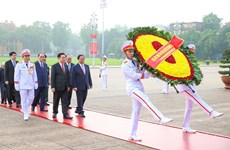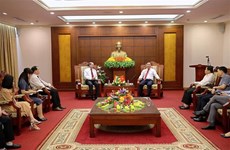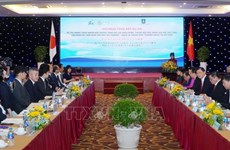Vietnam-Japan relations geared towards greater effectiveness
Prime Minister Nguyen Tan Dung’s visit to Japan from October 30 to
November 2 is aimed at promoting the friendship and cooperation between
Vietnam and Japan in a more in-depth, substantial and effective manner.
Prime Minister Nguyen Tan Dung’s visit to Japan from October 30 to
November 2 is aimed at promoting the friendship and cooperation between
Vietnam and Japan in a more in-depth, substantial and effective manner.
Vietnam and Japan established diplomatic ties on September 21, 1973. In recent years, the two countries maintained the exchange of high-level visits to increase bilateral cooperation.
In May 2007, the two countries established a Joint Commission for Cooperation co-chaired by the two Foreign Ministers.
They signed a joint statement on comprehensive development of the strategic partnership for peace and prosperity in Asia in October 2010, during Japanese Prime Minister Naoto Kan’s visit to Vietnam.
Japan is currently Vietnam’s third largest trading partner. The year 2010 marked an impressive recovery of bilateral trade, which hit 16 billion USD, a year-on-year increase of 22 percent.
Two-way trade has by September this year reached 15 billion USD, including 7.5 billion USD from Vietnamese exports.
Vietnam exports to Japan seafood, apparels, crude oil, electric cable, coal and wood products, and imports machineries, equipment, computers, electronics and spare parts, steel, cloth, automobile spare parts and materials for the textile and leather tanning industries.
In June 2008, the two sides began to work on the third phase of the Vietnam-Japan Initiative aimed at improving Vietnam’s investment climate and its competitiveness, supporting cooperation in the Development Triangle, the East-West Corridor and the Greater Mekong Sub-region, as well as addressing traffic congestion in Hanoi and Ho Chi Minh City.
They have completed the third phase on improvement of investment climate and just launched the fourth phase focusing on 70 items.
Japan had by August 2011 run 1,572 valid projects in Vietnam capitalised at 21.78 billion USD, ranking fourth among foreign investors in the country.
Japan is the largest ODA provider for Vietnam with 1.76 billion USD committed in the 2010 fiscal year to support Vietnam’s infrastructure development, climate change adaptation and poverty reduction efforts.
Despite domestic economic difficulty, Japan has confirmed that it will maintain ODA provision for Vietnam .
Bilateral cooperation in other fields also saw good progress, especially in tourism, culture and education.
Japan is among the five countries that have the largest numbers of visitors to Vietnam. Japanese visitors make up nearly 10 percent of total foreign arrivals to Vietnam.
Cultural exchanges between the two countries have flourished with such activities as exhibitions, film festivals, art performances and other cultural events held. A Japanese cultural exchange centre in Vietnam was established in March 2008 to increase cultural exchange and cooperation. Japan has also developed projects to help Vietnam preserve and restore ancient houses across the country.
In addition, Japan is one of the largest non-refundable aid donors for Vietnam in education and training./.
Vietnam and Japan established diplomatic ties on September 21, 1973. In recent years, the two countries maintained the exchange of high-level visits to increase bilateral cooperation.
In May 2007, the two countries established a Joint Commission for Cooperation co-chaired by the two Foreign Ministers.
They signed a joint statement on comprehensive development of the strategic partnership for peace and prosperity in Asia in October 2010, during Japanese Prime Minister Naoto Kan’s visit to Vietnam.
Japan is currently Vietnam’s third largest trading partner. The year 2010 marked an impressive recovery of bilateral trade, which hit 16 billion USD, a year-on-year increase of 22 percent.
Two-way trade has by September this year reached 15 billion USD, including 7.5 billion USD from Vietnamese exports.
Vietnam exports to Japan seafood, apparels, crude oil, electric cable, coal and wood products, and imports machineries, equipment, computers, electronics and spare parts, steel, cloth, automobile spare parts and materials for the textile and leather tanning industries.
In June 2008, the two sides began to work on the third phase of the Vietnam-Japan Initiative aimed at improving Vietnam’s investment climate and its competitiveness, supporting cooperation in the Development Triangle, the East-West Corridor and the Greater Mekong Sub-region, as well as addressing traffic congestion in Hanoi and Ho Chi Minh City.
They have completed the third phase on improvement of investment climate and just launched the fourth phase focusing on 70 items.
Japan had by August 2011 run 1,572 valid projects in Vietnam capitalised at 21.78 billion USD, ranking fourth among foreign investors in the country.
Japan is the largest ODA provider for Vietnam with 1.76 billion USD committed in the 2010 fiscal year to support Vietnam’s infrastructure development, climate change adaptation and poverty reduction efforts.
Despite domestic economic difficulty, Japan has confirmed that it will maintain ODA provision for Vietnam .
Bilateral cooperation in other fields also saw good progress, especially in tourism, culture and education.
Japan is among the five countries that have the largest numbers of visitors to Vietnam. Japanese visitors make up nearly 10 percent of total foreign arrivals to Vietnam.
Cultural exchanges between the two countries have flourished with such activities as exhibitions, film festivals, art performances and other cultural events held. A Japanese cultural exchange centre in Vietnam was established in March 2008 to increase cultural exchange and cooperation. Japan has also developed projects to help Vietnam preserve and restore ancient houses across the country.
In addition, Japan is one of the largest non-refundable aid donors for Vietnam in education and training./.













